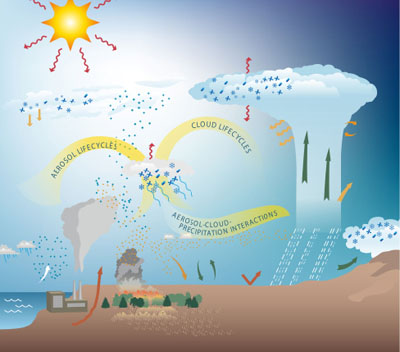The Atmospheric System Research (ASR) program is a key U.S. research activity addressing a broad area of uncertainty in earth system models: the interdependence of clouds, atmospheric aerosols, and precipitation, and how they influence Earth’s radiative balance and hydrological cycle. ASR coordinates closely with the Atmospheric Radiation Measurement (ARM) User Facility and takes advantage of ARM’s suite of measurements of radiation, aerosols, clouds, precipitation, and thermodynamics from its long-term fixed sites, mobile facility deployments, and aerial facility campaigns.
ASR supports research at DOE National Laboratories, universities, and throughout the broader research community that uses observations (primarily from ARM) along with process modeling and laboratory experiments to improve understanding and model representation of atmospheric processes and tests the atmospheric physics theories that are the foundation of Earth system models.
In close collaboration with the ARM user facility, ASR seeks to improve understanding and quantify the interactions between clouds, aerosols, precipitation, and the Earth’s surface with the goal of improving the representation of atmospheric processes in dynamic models across a range of scales.
ASR has four priority research areas corresponding to atmospheric regimes with large uncertainties in earth system prediction—aerosol processes, warm boundary-layer processes, convective processes, and high-latitude processes. To better connect research teams working on these processes and their interactions, ASR is organized into four working groups:

- Aerosol Processes – understanding and model representation of processes governing the spatial and temporal distribution of atmospheric particles and their chemical, microphysical, and optical properties.
- Warm Boundary Layer Processes – understanding and model representation of processes controlling the structural and radiative properties of clouds, aerosols and their interactions with the underlying surface in the lowest few kilometers of the atmosphere.
- Convective Processes – understanding and model representation of convective cloud processes and properties, including cloud cover, precipitation, life cycle, dynamics, and microphysics over a range of spatial scales.
- High-Latitude Processes – understanding and model representation of cloud, aerosol, and surface-interaction processes controlling the surface energy budgets in northern and southern high-latitude regions.

